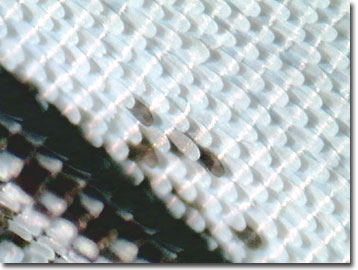Butterfly Wing Scale Digital Image Gallery
Redspot Sawtooth Butterfly
The common name of the redspot sawtooth butterfly spawned from the markings on its wings, which consist of a large red spot and a sawtooth pattern created by oblong yellow and white patches of wing scales. Although its appearance closely resembles the poisonous painted jezebel butterfly, the redspot sawtooth is not considered a mimic.

Classified by entomologists as Prioneris philonome, the redspot sawtooth butterfly is a member of the family Pieridae, which contains the white, sulfur, yellow, and orange tip butterflies. Three recognized subspecies of redspot sawtooth butterflies exist throughout its range of India and Southeast Asia. Essentially a forest species, the redspot sawtooth frequents open spaces along streams and is often observed drinking at seepages in mixed butterfly groups. The beautiful lepidopteran may also be seen sipping nectar from brightly colored flowers.
The other life stages of the redspot sawtooth butterfly are not as ostentatious as the adult stage. The slender redspot sawtooth eggs hatch into many small, hungry caterpillars that usually feed on the leaves of the plants that are the source of capers. As pierids, the larvae live in the open, and rely on camouflage for protection. The caterpillars are either green or reddish brown and are covered in fine hair, rather than spiky fleshy projections. The simple caterpillars appear rather plain when contrasted with lepidopteran larvae of other families, and the chrysalides, which are often green in color, are equally unpretentious.
In Vietnam, Cambodia, and Laos, the use of bombs, chemical defoliants, and napalm during the Vietnam War devastated much of the redspot sawtooths forest habitat. Localized over-collecting coupled with continual destruction of the tropical rainforests of Southeast Asia and the Malay Archipelago has also stressed populations of the species. The development of ecologically based tourism and increasing demand for specimens by collectors, however, may result in a brighter future for the redspot sawtooth and other imperiled butterflies. Conservation measures and habitat restoration may ensue as the concept of butterflies as valuable and renewable resources becomes increasingly significant in the economies of their native countries.
Contributing Authors
Cynthia D. Kelly, Shannon H. Neaves, Laurence D. Zuckerman, and Michael W. Davidson - National High Magnetic Field Laboratory, 1800 East Paul Dirac Dr., The Florida State University, Tallahassee, Florida, 32310.
BACK TO THE BUTTERFLY WING SCALE IMAGE GALLERY
BACK TO THE DIGITAL IMAGE GALLERIES
Questions or comments? Send us an email.
© 1995-2025 by Michael W. Davidson and The Florida State University. All Rights Reserved. No images, graphics, software, scripts, or applets may be reproduced or used in any manner without permission from the copyright holders. Use of this website means you agree to all of the Legal Terms and Conditions set forth by the owners.
This website is maintained by our
Graphics & Web Programming Team
in collaboration with Optical Microscopy at the
National High Magnetic Field Laboratory.
Last Modification Friday, Nov 13, 2015 at 01:19 PM
Access Count Since January 21, 2003: 9407
Visit the website of our partner in introductory microscopy education:
|
|
